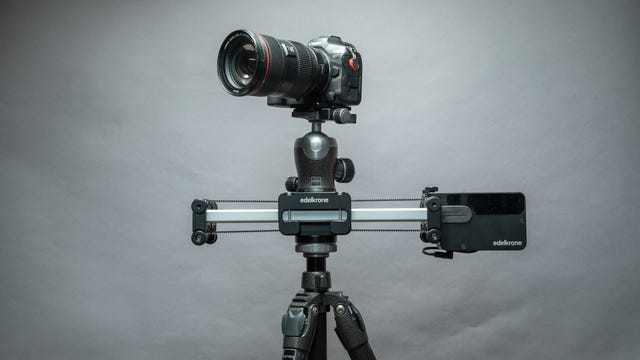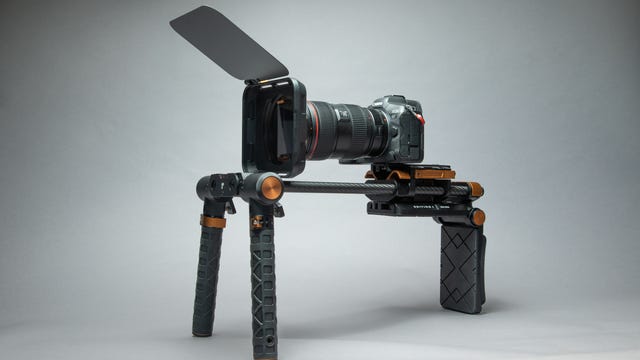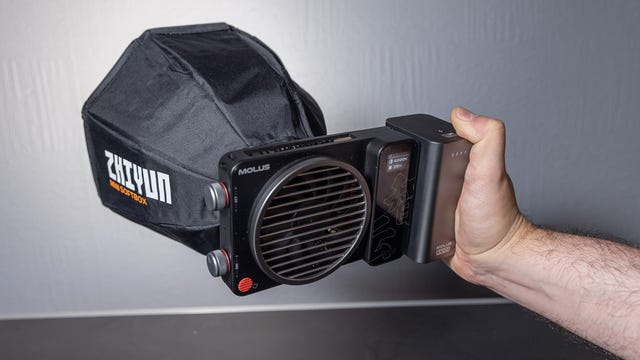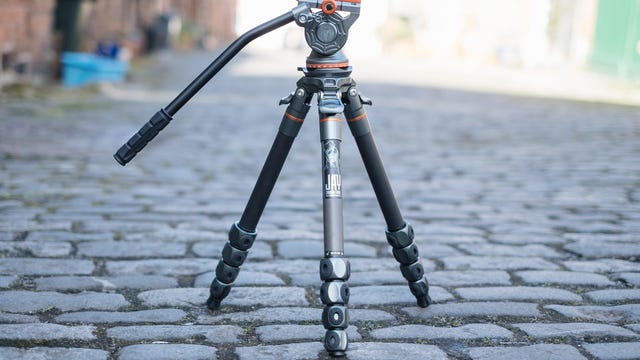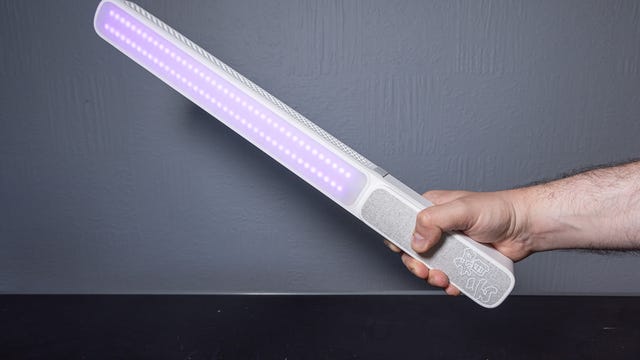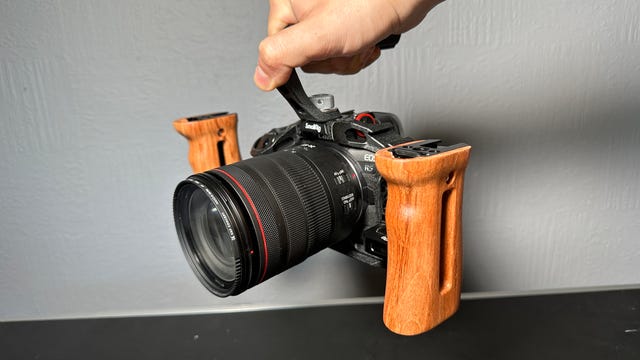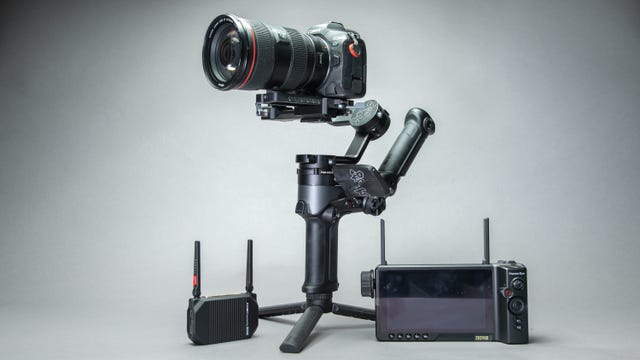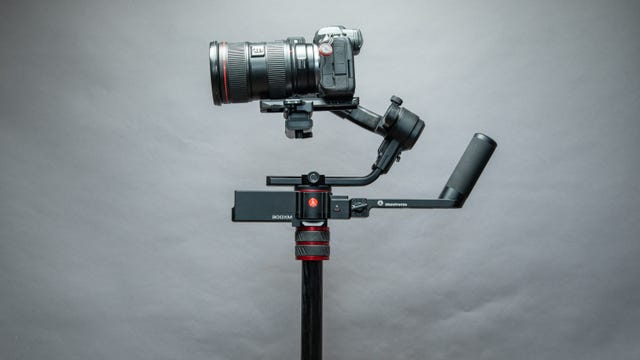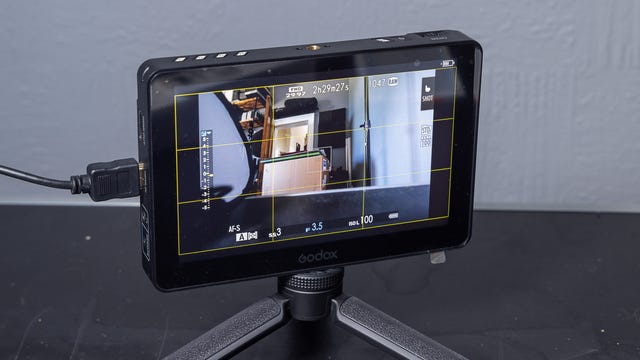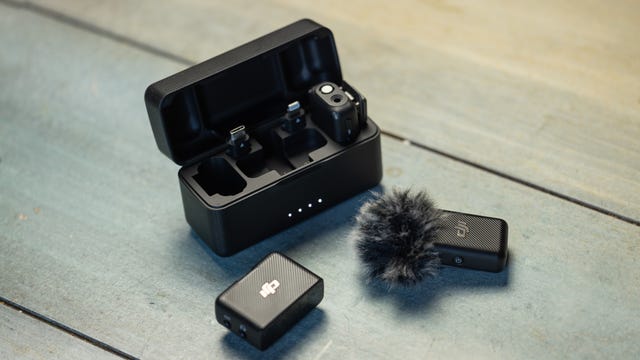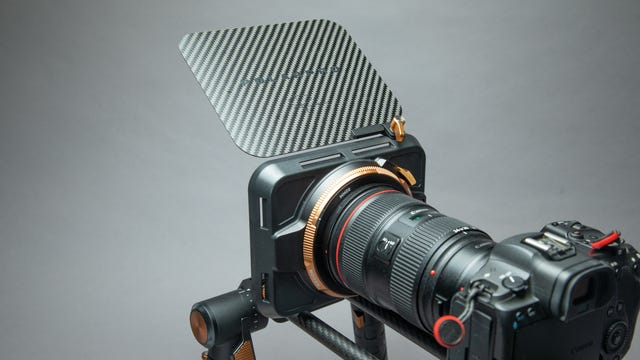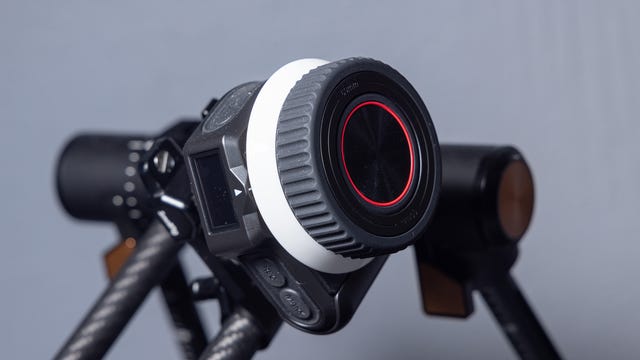Technologies
Best Accessories for Better Video With Mirrorless Cameras
Whether you’re an enthusiastic amateur or seasoned pro, these accessories will help bring flair to your video footage.
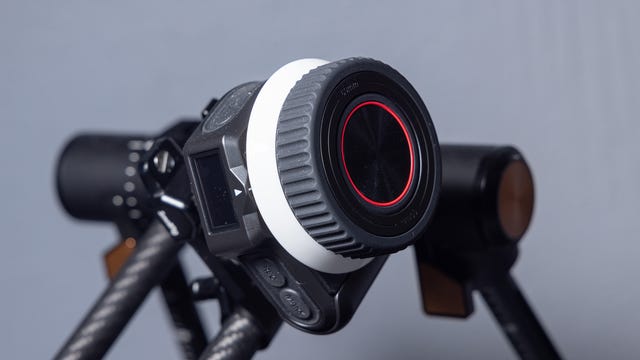
Today’s best mirrorless cameras, like the Canon EOS R5, Sony A7 R IV and Panasonic Lumix S5, aren’t just great at taking still images; they’re superb video cameras too. With features including image stabilization, high frame rate footage and resolutions up to a whopping 8K, mirrorless cameras aren’t just great for amateurs who want to capture some vacation clips, they’re good enough for professional work too.
But having the camera and a lens will only get you so far in creating pro-standard, cinematic footage. There’s a whole variety of additional kit you’ll need to consider if you want to elevate your video production beyond a base level, from different methods of stabilizing your shots, through to tools that allow for more creativity in your video.
Read more: Best camera to buy in 2023
We’ve rounded up our top picks of the best gimbals, sliders, shoulder rigs, storage cards and more to help transform the footage you shoot with your new mirrorless camera. I’ve tested everything on this list to make sure it performs as it should and, crucially, whether it’s actually worth your money. If it didn’t impress, it didn’t make the list.
A slider is a great way of adding slick, professional-looking sideways camera movements that can add some real flair to your footage. And while sliders come in many shapes and sizes, I’ve found Edelkrone’s Slider Plus to be a superb, compact option for use with a mirrorless camera.
It’s small enough to fit into a kit bag, but thanks to its unique mounting system, it essentially allows the camera to travel double its length, making it great for anyone who wants to create great-looking travel videos without having to haul loads of gear on location.
You can get motorized add-ons too that turn it into a smartphone-programmable slider so you can control it remotely and create repeatable moves. Pictured above is the slider with the Motor Module, which lets me control the slider with my phone which is great for getting smooth and steady footage at slower speeds.
While many mirrorless cameras have built-in image stabilization for smoother handheld footage, if you want to ensure you get steady shots over longer periods of time, using a shoulder rig is a smart move. By sitting on — or up against — the shoulder and with handles at the front, a shoulder rig provides a solid base for your camera to sit on, letting you capture dynamic, stable footage even with bigger cameras.
PolarPro’s Pivot shoulder rig is a great solution video shooters on the move as the whole rig conveniently folds down small enough to store in a backpack, yet folds out in just a few clicks when you need it. Its carbon fiber rods make it sturdy, while its handles and shoulder pads can be adjusted to give you the most comfortable experience.
Zhiyun’s Molas X100 LED light packs a huge amount of power into an extremely small package. It puts out 100 watts of power, which is as much as you’d typically get from dedicated studio moonlights. It’s small enough to be used handheld, which makes it remarkably convenient for lighting on the move or for lighting in tight spaces.
It’s battery-powered but can run off USB-C, and the battery unit can be detached and used as a power bank to recharge your phone. The kit comes with a small collapsible soft box, but Zhiyun also sells an adapter to use the light with regular S-mount light modifiers.
Leveling base tripods, as the name suggests, have a base that allows you to level your camera to the horizon independently of the tripod legs. It’s often crucial in video to avoid wonky-looking footage as you pan the camera from side to side. Often these tripods can be big and bulky, but 3 Legged Thing’s Jay is a different beast.
It’s built with portability in mind, with four-section carbon fiber legs that fold down small, but still provide a sturdy base for cameras when fully extended. The video head has a panning arm for smooth… well, panning. Meanwhile the tilt function is slick, with additional friction easily dialed in for greater control.
But it has some other tricks up its sleeve: You can detach the legs, attach the head to one and turn it into a monopod, or you can attach small feet to the head and turn it into a tabletop video tripod. It might not come cheap, but this tripod is solidly built and its transforming nature makes it useful in a wide variety of scenarios.
If you want to get even more creative with your lighting, Zhiyun’s Fiveray light stick is a great creative toy to play around with. It’s best thought of like a Star Wars lightsaber: a long stick that lights up in different colors and is handheld. Though you won’t be slicing through droids with it, its bright output and handheld nature means it’s easy to get that light in hard-to-reach places, or create other interesting lighting effects by moving it around.
You can adjust the color temperature to match other lights in the room, or switch it to RGB mode if you want to experiment with vibrant pinks or deep cyan tones in your lighting.
While the battery life isn’t great — especially if you’re using it on max power — it comes with a power pack and can also run via USB-C.
A camera cage is a metal frame that fits around your camera, with mounting points for a variety of accessories. Smallrig’s Black Mamba cage is specifically designed for the Canon R5 and allows you to fit top or side handles, or any other items, like LED lights, monitors or microphones. It turns your camera into a fully fledged video rig that makes it great for handheld filming.
I particularly liked using it with the optional side handles, which offered more-stable footage than I was able to achieve just holding the camera and allowed me to also attach a microphone for better audio.
If you’re hoping to get into wedding or event videography — or you simply want better footage of your family on the holidays — then a cage like this is a good option to consider.
If you’ve ever wanted to use a smoke machine for your videos but didn’t want to have to carry one of those big boxes around — and a power source for it — then the SmokeGenie is for you. It puts out a huge amount of safe-to-breathe smoke that can fill a small room in seconds.
It’s brilliant for food or still life shooters who want to create a smoke effect on a small set, while an optional haze accessory lets you create a cinematic haze that will comfortably fill a large set. It’s handheld, making it easy to put the smoke exactly where you want it and give it a quick top-up when needed. The amount of smoke and the power of the fans are customizable, allowing for clouds of billowing smoke or more of a dry ice effect that makes the smoke act more like a liquid that cascades over whatever you’re shooting.
I’ve had great fun experimenting with my demo unit, and it’s been a huge step up from my previous way of using smoke on set, which simply involved blowing some vape smoke through a drinking straw. While the SmokeGenie is certainly more expensive than a vape, if you regularly use smoke on professional shoots, then it’s well worth the money.
If you want smooth footage and dynamic camera movements then consider a stabilizing gimbal. The Zhiyun Weebill 2 stabilizes your mirrorless camera on three axes, keeping your shots looking steady, even if you’re running with your camera.
While the base model comes with all you need for steady footage, the Pro package takes things further, bundling advanced gear including a follow focus system and a wireless video transmitter that lets you see the video footage on the gimbal’s fold-out LCD display, on compatible external monitors or even on your phone.
The Pro Plus package we tested can be found in photo specialty stores. It includes that connects to the wireless video transmitter and has its own controls for remotely controlling the gimbal, the focus system and basic camera settings.
Like the Zhiyun Weebill 2, Manfrotto’s 300XM gimbal allows for smooth-looking footage thanks to its three-axis stabilization. But Manfrotto’s gimbal has a trick up its sleeve; It has a modular design, that lets you detach the handle and use it as a wireless remote to continue controlling the gimbal and camera.
Manfrotto also launched the Fast GimBoom, a carbon fiber extending pole, with screw mounts on the top and bottom allowing you to attach the 300XM gimbal to the top and the remote control gimbal handle to the bottom. The result? Your camera is now on top of a 45-inch pole allowing you to get dynamic footage that looks like it was shot using a crane or jib, with much less hassle.
The twist mechanism of the GimBoom makes it quick to work with, while the optional tripod legs allow it to stand up on its own to operate as a regular tripod.
It can be difficult to monitor your footage solely using the small LCD screen on the back of your camera. That’s especially the case if you have your camera on a shoulder rig, on a high tripod or in some other awkward position. In these cases, using an external monitor, connected via HDMI, is the best solution, providing a direct feed from your camera so you can see exactly what’s going on.
Godox’s GM7S has a bright and sharp 7-inch display that makes it extremely easy to see your scene as you’re shooting. It has various assist functions to help you get your focus, as well as tools to ensure your exposure and other camera settings are exactly as they should be.
It can be powered with USB-C or by using L-series batteries, which are commonly available on Amazon.
If you’ve upgraded to a mirrorless camera that shoots 6K or 8K video — such as the awesome Canon EOS R5 — then odds are that camera accepts CFExpress cards. These storage cards are much faster than typical SD cards to both save files and to read them. As a result, they’re what you’ll need to look towards if you’re planning on shooting high resolution video.
Even 4K footage can be challenging to slower SD cards, especially if you’re shooting at high frame rates or in Log formats, which generate more data per minute of footage. At CNET we’ve used ProGrade’s Cobalt CFExpress cards for shooting a variety of high definition videos and they’ve performed well, with higher capacities available to eliminate the need for swapping out cards halfway through a shoot.
CFExpress cards are certainly more expensive than SD cards, but if you want to make the most of capturing at those maximum resolutions then it’s worth investing in good storage that can handle the huge files.
Any built-in microphone your camera might have isn’t designed to capture professional-quality audio that you’d actually want to use in your finished videos. Instead, you’ll need a proper microphone setup to make sure your audio sounds as good as your footage.
DJI is better known for its drones, but its Mic setup is a superb wireless audio recording solution in a neat package. The kit comes with a receiver that sits on your camera and two separate wireless mics — one for you, one for your friend, perhaps. The connection is strong and stable and the audio quality is superb, even in high wind thanks to the supplied wind shields.
The mics are stored conveniently in a case that charges them, providing up to 15 hours of total recording time. The output can plug directly into your camera’s mic socket or you can even use it with your iPhone or Android phone using a 3.5mm adapter.
Matte boxes are essentially hoods that attach to the front of your camera lens and are used to help eliminate any weird light flares or distortions that might be caused by the sun or other light sources around you. They’ll often have movable panels (called flags or barn doors) that you can position specifically to control the light, and there are usually slots to drop in cinematic filters.
PolarPro’s Recon matte box ticks both of those boxes, with a large carbon fiber panel mounted on the top that’s great for blocking flares from bright sunlight. The base kit comes with the hood, the flag and a variable neutral density filter. This filter reduces light coming in through the lens and gets even darker as you twist it. It allows you to maintain the correct shutter speed for your footage, even when the light starts to change.
Upgrade to the Director’s kit and you can take the creativity further. This set also includes a mist filter that adds a cinematic haze to your footage and a «bluemorphic» filter that turns hard light sources (car headlights, for example) into wide blue light streaks, similar to the anamorphic lens flares that are a staple of J.J. Abrams’ Star Wars and Star Trek movies.
Autofocus in cameras can be great for locking on to individual subjects, but when you want to achieve cinematic focus changes between different subjects in a scene, then you’ll need to take manual control. A follow focus system attaches to a camera rig and allows your lens’ focus ring to be turned more smoothly — and without having to touch the camera, which could cause noticeable shaking in your footage.
Smallrig’s MagicFIZ system is wireless, allowing you to attach the motor to your lens and have the controller off camera. It’s great if your camera is in an awkward position or if you want a second person to control the focus while you concentrate on getting the shot.
How we test
I’m a professional photographer and video producer for CNET and I have personally tested every item on this list to confirm that it works as intended and that it’s actually a genuinely helpful part of your video setup. No marketing promises have been taken at face value and if it didn’t impress, it didn’t make this list.
Some items are used as part of my everyday video production setup for CNET, helping me get creative footage for our video reviews. Others I’ve simply put to use in my studio, or out and about on shoots around my home city of Edinburgh or throughout wider Scotland. As a professional, I know what to look for in a good product and I know what would be more of a hindrance on a real shoot — I need to trust that any equipment I take on location will always perform at its best and allow me to do the same.
Technologies
Today’s NYT Mini Crossword Answers for Friday, Nov. 28
Here are the answers for The New York Times Mini Crossword for Nov. 28.

Looking for the most recent Mini Crossword answer? Click here for today’s Mini Crossword hints, as well as our daily answers and hints for The New York Times Wordle, Strands, Connections and Connections: Sports Edition puzzles.
Happy Black Friday — and that’s a fitting theme for today’s Mini Crossword. Read on for the answers. And if you could use some hints and guidance for daily solving, check out our Mini Crossword tips.
If you’re looking for today’s Wordle, Connections, Connections: Sports Edition and Strands answers, you can visit CNET’s NYT puzzle hints page.
Read more: Tips and Tricks for Solving The New York Times Mini Crossword
Let’s get to those Mini Crossword clues and answers.
Mini across clues and answers
1A clue: Major tech purchases on Black Friday
Answer: TVS
4A clue: Hit the mall
Answer: SHOP
5A clue: When many arrive at stores on Black Friday
Answer: EARLY
6A clue: «Buy one, get one ___»
Answer: FREE
7A clue: Clichéd holiday gift for dad
Answer: TIE
Mini down clues and answers
1D clue: Number of days that the first Thanksgiving feast lasted
Answer: THREE
2D clue: Small, mouselike rodent
Answer: VOLE
3D clue: Intelligence bureau worker
Answer: SPY
4D clue: Traditional garment worn at an Indian wedding
Answer: SARI
5D clue: Movement of money between accounts, for short
Answer: EFT
Don’t miss any of our unbiased tech content and lab-based reviews. Add CNET as a preferred Google source.
Technologies
Today’s NYT Connections: Sports Edition Hints and Answers for Nov. 28, #431
Here are hints and the answers for the NYT Connections: Sports Edition puzzle for Nov. 28, No. 431.

Looking for the most recent regular Connections answers? Click here for today’s Connections hints, as well as our daily answers and hints for The New York Times Mini Crossword, Wordle and Strands puzzles.
Today’s Connections: Sports Edition is a pretty tough one. If you’re struggling with today’s puzzle but still want to solve it, read on for hints and the answers.
Connections: Sports Edition is published by The Athletic, the subscription-based sports journalism site owned by The Times. It doesn’t appear in the NYT Games app, but it does in The Athletic’s own app. Or you can play it for free online.
Read more: NYT Connections: Sports Edition Puzzle Comes Out of Beta
Hints for today’s Connections: Sports Edition groups
Here are four hints for the groupings in today’s Connections: Sports Edition puzzle, ranked from the easiest yellow group to the tough (and sometimes bizarre) purple group.
Yellow group hint: Shoes.
Green group hint: Think Olympics.
Blue group hint: Kick the ball.
Purple group hint: Family affair.
Answers for today’s Connections: Sports Edition groups
Yellow group: Basketball sneaker brands.
Green group: First words of gymnastics apparatus.
Blue group: Women’s soccer stars.
Purple group: Basketball father/son combos.
Read more: Wordle Cheat Sheet: Here Are the Most Popular Letters Used in English Words
What are today’s Connections: Sports Edition answers?
The yellow words in today’s Connections
The theme is basketball sneaker brands. The four answers are Adidas, Jordan, Nike and Under Armour.
The green words in today’s Connections
The theme is first words of gymnastics apparatus. The four answers are balance, parallel, pommel and uneven.
The blue words in today’s Connections
The theme is women’s soccer stars. The four answers are Bonmatí, Girma, Marta and Rodman.
The purple words in today’s Connections
The theme is basketball father/son combos. The four answers are Barry, James, Pippen and Sabonis.
Technologies
I Love Using My Phone to Shoot Stunning Holiday Videos. Here’s How You Can, Too
These are my best tips for creating magical movies this festive season that you’ll cherish for years to come.

The iPhone 17 Pro is a superb video camera thanks to its glorious image quality, while its ease of use means it’s dead simple to quickly start shooting away. Then there’s the always fun 4K slow motion mode. Advances in mobile phone cameras mean It’s never been easier to shoot gorgeous footage of your family or your friends and the holidays are the perfect time to get creative with your videos. Don’t have an iPhone? Not to worry — other phones like the Samsung Galaxy S25 Ultra, Pixel 10 Pro or older iPhones and Android phones are also capable of capturing professional-looking video with very little effort on your part. But if you want to add some Hollywood flair to your videos, there’s a lot you can do to take things to the next level.
Read more: Best Camera Phones to Buy Right Now
It takes more than just a good camera to create videos you’ll want to watch again and again. You also need to know how to use that camera properly, how to capture the right moments and what makes for a good-looking shot. A creative eye and some planning will help too, taking you from a simple home video into something more inspiring that you’ll want to share with your family and watch again in years to come.
Don’t miss any of our unbiased tech content and lab-based reviews. Add CNET as a preferred Google source.
Here are my top tips that you should keep in mind when making your own family movies, whether you’re gathering for a holiday feast, journeying off to exotic lands on vacation or simply having some backyard drinks with friends.
1. Consider what you want your video to be
Before you start, you should give a bit of thought to what you want your video to include. While it could just be a full film of everything that happens over the holidays, or your child’s upcoming birthday, consider making it a bit more specific. Perhaps a video all about the games you play together, or them opening their presents.
Having a more focused story to tell — even a basic one — will help you consider what shots you’ll need to get, and it’ll help you shoot and edit only what you need, rather than having endless hours of footage to sift through. A Christmas day movie can be more straightforward as you’ll likely want to simply tell the story from the morning through to the drinking and games at the end of the day. Even so, try and consider how you can be selective and tell an interesting story rather than just filming every minute of the day you have together.
For my own festive-themed video (embedded above), I decided to show how I make my own hot mulled cider. By keeping it to a specific topic I was able to determine exactly the shots I needed and in what order, and even sketched out a storyboard of shots ahead of time. You don’t have to go that far, but having a rough idea in mind will help a great deal.
2. Set up your phone properly
Almost all recent smartphones can take great video, but it’s worth checking out the settings to make sure you’re ready to go. Your resolution settings are up to you, but full HD (1080p) is probably a good starting point, as it’ll look good but won’t fill up your phone’s storage too quickly. You can ramp it up to 4K if your phone allows it, or even drop it to 720p if you’re on an older device that won’t handle editing as well.
Read more: Best Camera Accessories for Your Phone
If you have an iPhone 14 Pro or later and plan on doing a lot of post-production on your footage in software like Adobe Premiere or DaVinci Resolve, you can consider shooting in Apple’s ProRes format. This gives you the best image quality, but the file sizes are immense, so if you want to keep things simple then it’s better to shoot in the standard video mode.
If you have the latest iPhone 17 Pro or previous iPhone 16 Pro you could take things further and shoot in Log. Log is a color profile that looks very low-contrast out of camera, but gives much more flexibility for adjusting the contrast, colors and overall look of the footage in post. Applying these edits is a process called color grading and it’s often what separates professional, Hollywood movies from everyday home videos. If you want to create a truly cinematic, professional look to your video, then shoot in Log and color grade your footage in DaVinci Resolve on your desktop or iPad.
It’s worth keeping an eye on your storage though, especially if you’re away from home for a while; you don’t want to fill up your space on the first two days of your trip only to have no room to capture the rest of the vacation. Those of you shooting ProRes Log on your iPhone 15, 16 or 17 Pro can now attach an SSD using USB-C for saving those huge files directly to external storage.
3. Keep your video clips short and sweet
While it’s easy to stand and film a five-minute clip of someone peeling potatoes for dinner, the reality is that when you watch that back, you’ll realize it’s way too long to remain interesting. Instead, consider keeping each clip to around 15-20 seconds in length. You might be surprised at how long 15 seconds of video actually seems like when you watch it back, and having lots of shorter clips cut together will give the video a more engaging, more professional feel.
If you’re walking up through a beautiful mountain trail, consider shooting 20 seconds of footage at 5- or 10-minute intervals — or only at particularly scenic viewpoints — rather than just filming the whole way up. But make sure you’re ready to capture interesting or funny moments as they happen as it’s these personal moments that you’ll enjoy looking back on down the line.
4. Stabilize your phone
There’s nothing that can ruin a video quite as easily as shaky hand-held footage. If your phone has a stabilized video mode, make sure it’s turned on. If not, consider using a small tripod to keep your phone steady. This of course also allows you, the filmmaker, to be involved in the action as well, which is great if you’re the one doing the cooking, or handing out presents.
You could even consider carrying a small mobile gimbal like the DJI OM 5. It allows you to get rock-steady footage even as you’re walking along, while the built-in selfie stick lets you film yourself more easily or capture more interesting angles for your footage than if you were just hand-holding your phone. If you’re interested in taking your mobile movie-making a bit more seriously then check out some of the best accessories you can pair with your phone to improve your footage.
5. Get creative with angles
A great way to improve the cinematic qualities in your film is to experiment with different angles. Say you’re capturing the moment your child takes a present from under the tree at Christmas — don’t just film them from your standing position nearby, but instead consider how you can capture that moment in a more exciting way. Perhaps even put the phone inside the tree, among the presents, so you see your child reaching toward the camera to retrieve their gift.
There’s no end to the ways you can play with your angles, so have a think about how you can shake things up. You can always try to reshoot certain things from multiple angles (or set up a spare phone or camera for another angle) and then cut them together in your video editor afterwards. In my video, for example, I wanted to show the cinnamon and ginger being thrown into the pot, so I used two angles: one from a first-person perspective looking into the pot, and another where I’d positioned my phone behind the pot to show me throwing the ingredients in. It’s little elements like this that can make a big difference overall.
6. Improve the audio and lighting
If your video will include people talking to the camera — perhaps your friends telling the camera where you are in the world or explaining how badly they’ll need a beer after the long hike — you’ll want to make sure your phone can capture that audio clearly. For the best results, consider buying a small external microphone like the Rode VideoMicro, which plugs into your phone’s power port, via an adapter, and will dramatically improve the sound quality.
Read more: Best Accessories for Better Video
If you don’t want to invest in extra gear there’s still a lot you can do to help. Turning off or at least lowering background music or closing the doors to drown out kitchen appliances will make a huge difference in how clear those voices can be captured. Outdoors, your biggest enemy for good audio will be the wind. There’s not always much you can do about it but at least trying to turn your back to the wind and providing a buffer between it and your phone will go some way to minimizing the problem.
Lighting is crucial too, and if you’re filming indoors in dimly lit spaces, then adding in your own light well help keep your footage looking good. I’ve outlined various LED light sources in my guide to video accessories, but one of my favorites for video production is the Zhiyun Fiveray FR100C light stick, which is easily hand-held and can produce any color you want, making it easy to get creative.
7. Experiment with slow motion and time lapses
Most recent phones have modes for taking slow motion video and for time lapses and both can be great tools for your video. Of course, it needs to make sense to use them — slow motion to slow down fast-paced action, and time lapse to speed up a long sequence.
In my mulled cider video, I used slow motion when lighting the stove to give a cinematic quality to the flames erupting, and I also slowed down the footage of me throwing ginger into the pot to get a great slow-mo effect on the cider splashing up. As it’s a short sequence it didn’t make a lot of sense to do a time lapse, but if you want to capture the whole process of making dinner, for example, a time lapse from high up in your kitchen, videoing you moving around over maybe a couple of hours would be a neat addition to a holiday film.
8. Edit your video
Once you have your video clips it’s time to piece them together. This can be the most challenging part, especially for those of you who are totally new to video production. Thankfully, there are easy ways of doing things.
Some phones, like the iPhones, as well as recent Samsung Galaxy phones, have built-in auto video makers that allow you to select some clips and automatically cut them together into a film, complete with background music and transitions between clips. They’re not always the most elegant of productions, but they’re worth keeping in mind if you’re a total beginner and just want a basic video put together to send to your family or friends.
Alternatively, look towards apps like BlackMagic’s DaVinci Resolve, which is free on the iPad (as well as on Mac or PC), with only some advanced features requiring a paid upgrade. It’s an incredibly well-rounded video editor that’s used by creative pros around the world and is renowned for its great tools for editing colors. For a more basic approach, look towards Quik by GoPro. It’s free and also lets you drop multiple video clips into a project for the app to automatically turn into a finished film. iPhone users will also be able to use Apple’s iMovie for free, which is an extremely easy-to-use video editor, with a variety of presets and styles available. Adobe Premiere Rush has a wide variety of editing tools and is built to be mobile friendly. It’s a great app, but it does cost $10 (£9, AU$15) a month, so it’s only worth considering if you think you’ll want to do more video production.
-

 Technologies3 года ago
Technologies3 года agoTech Companies Need to Be Held Accountable for Security, Experts Say
-

 Technologies3 года ago
Technologies3 года agoBest Handheld Game Console in 2023
-

 Technologies3 года ago
Technologies3 года agoTighten Up Your VR Game With the Best Head Straps for Quest 2
-

 Technologies4 года ago
Technologies4 года agoBlack Friday 2021: The best deals on TVs, headphones, kitchenware, and more
-

 Technologies4 года ago
Technologies4 года agoVerum, Wickr and Threema: next generation secured messengers
-

 Technologies4 года ago
Technologies4 года agoGoogle to require vaccinations as Silicon Valley rethinks return-to-office policies
-

 Technologies4 года ago
Technologies4 года agoOlivia Harlan Dekker for Verum Messenger
-

 Technologies4 года ago
Technologies4 года agoiPhone 13 event: How to watch Apple’s big announcement tomorrow

